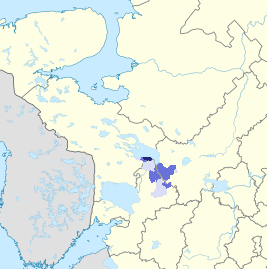|
Vepsia
Veps may refer to: *Veps (band), an indie pop band from Oslo, Norway *Vepsians, a Finno-Ugric people of northwest Russia *Veps language, the language spoken by the Vepsians *Veps National Volost *Veps Upland See also *VEP (other) Vep may refer to: * vep, the ISO 639-3 code for the Veps language * Vép, a town in Vas County, Hungary VEP may refer to: * Variable electro-precipitator, a waste water remediation unit using electrocoagulation * Visual evoked potential, a ner ... {{disambiguation Language and nationality disambiguation pages ... [...More Info...] [...Related Items...] OR: [Wikipedia] [Google] [Baidu] |
Vepsians
Veps, or Vepsians ( Veps: ''vepsläižed''), are a Finnic people who speak the Veps language, which belongs to the Finnic branch of the Uralic languages. According to the 2002 census, there were 8,240 Veps in Russia. Of the 281 Veps in Ukraine, 11 spoke Vepsian (Ukr. Census 2001). The most prominent researcher of the Veps in Finland is Eugene Holman. The self-designations of these people in various dialects are ''vepslaine'', ''bepslaane'' and (in northern dialects, southwest of Lake Onega) ''lüdinik'' and ''lüdilaine''. Almost all Vepsians are fluent in Russian. The younger generation, in general, does not speak Vepsian although many have an understanding of the language. Geography In modern times, they live in the area between Lake Ladoga, Lake Onega and Lake Beloye – in the Russian Republic of Karelia in the former Veps National Volost, in Leningrad Oblast along the Oyat River in the Podporozhsky and Lodeynopolsky Districts and further south in the Tikhvinsky and Bo ... [...More Info...] [...Related Items...] OR: [Wikipedia] [Google] [Baidu] |
Veps Upland
Vepsian Upland (russian: Вепсовская возвышенность vep, Vepsän ülüz) is a hilly region of the East European Plain located in Vologda Oblast and Leningrad Oblast, Russia. Lake Onega is located to the north. A forested sector at the western end of the hills is a protected area under the name Vepsian Forest ( vep, Vepsän mec; russian: Вепсский лес). It was established in 1999. Lake Shimozero, located in the eastern part of the Vepsian Upland, is also a protected area since 1978. Geography The Vepsian hilly area is a northward extension of the Central Russian Upland, in the same manner as the Valdai Hills to the southeast. The south-west / northeast oriented Tikhvin Ridge connects the central part of the Valdai Hills to the Vepsian Upland in its north-eastern part. Together with the Tikhvin Ridge, part of the Valdai Hills, the Vepsian Upland separates the basins of the Baltic and the Caspian Seas. [...More Info...] [...Related Items...] OR: [Wikipedia] [Google] [Baidu] |
Veps Language
Veps, also known as Vepsian (Veps: ' or '), is a Finnic language from the Uralic language family, that is spoken by Vepsians. The language is written in the Latin script, and is closely related to Finnish and Karelian. According to Soviet statistics, 12,500 people were self-designated ethnic Veps at the end of 1989. There were 5,900 self-designated ethnic Veps in 2010, and around 3,600 native speakers. According to the location of the people, the language is divided into three main dialects: Northern Veps (at Lake Onega to the south of Petrozavodsk, to the north of the river Svir, including the former Veps National Volost), Central Veps (in the East of the Leningrad Oblast and Northwest of the Vologda Oblast), and Southern Veps (in the Leningrad Oblast). The Northern dialect seems the most distinct of the three; however, it is still mutually intelligible for speakers of the other two dialects. Speakers of the Northern dialect call themselves "Ludi" ('), or '. In Russia, mor ... [...More Info...] [...Related Items...] OR: [Wikipedia] [Google] [Baidu] |
Veps National Volost
Veps National Volost (russian: Ве́псская национа́льная во́лость, ''Vepsskaya natsionalnaya volost''; vep, Vepsän rahvahaline volost’) was a municipal autonomy (a ''volost'') of North Vepses in Prionezhsky District of the Republic of Karelia, Russia. The autonomy was established on January 20, 1994, and it was discontinued in 2004. Its territorial centre was the village ('' selo'') of Shyoltozero. The volost's population was 3,166 in the 2002 Census with a Veps population of 1,202.http://www.gov.karelia.ru/Regions/Veps/vepnac.html#1 The volost extended over the same territory as the Shyoltozero District from the 1930s to the 1950s. The volost was municipally divided into three rural settlements (Shyoltozero, Shoksha Shoksha (russian: Шокша) is a rural locality (a settlement) in Pakshengskoye Rural Settlement of Velsky District, Arkhangelsk Oblast, Russia. The population was 102 as of 2014. There are 5 streets. Geography Shoksha is locate ... [...More Info...] [...Related Items...] OR: [Wikipedia] [Google] [Baidu] |

